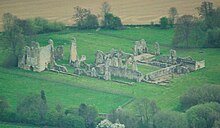Bayham Old Abbey

Bayham Old Abbey is an
Location

Bayham Abbey lies within the valley of the
The Abbey today
The abbey ruins are currently maintained by English Heritage. They largely consist of partial walls, though the room layouts can still be seen, and there remain many examples of ornate capitals and other carved stonework; including stone frameworks from the three giant windows comprising the nave. The quality of the work is particularly fine for a late thirteenth-century Premonstratensian abbey.
The abbey is sited on the Kent/Sussex border and is presumed to have had an entrance in each county. The ruins of a gatehouse, known as the Kentish gate, is situated nearby on the grounds. No trace has been found of the corresponding Sussex gate. Other buildings, normally associated with abbeys, such as stables and barns, are yet to be located.
Abbey history
Bayham Abbey was founded c. 1208 by the merger of two monasteries,
The abbey was built from local sandstone in the first half of the 13th century by Premonstratensian canons. By the 15th century the original design had been enlarged with new transepts, though the original transepts are still visible within the structure. The Abbey was home to Premonstratensian canons regular: that is to say they followed the life ascribed to
The abbey was suppressed by
The Camden family, descended from the Pratts, built the Dower house (otherwise known as Bayham Old Abbey House), on the estate as the old residence. The new grounds were landscaped by Humphry Repton, who included within his plans the old abbey, which Samuel Hieronymus Grimm had sketched about 1785, emphasising the grand scale and picturesque character of its ivy-clad walls.[6] Some modifications were made to the abbey during this time, memorialised in one of Repton's most complete "Red Books", with the inscription "Application of Gardening and Architecture united, in the formation of a new place".[7]
In 1872, the Camden family moved to the other side of the Teise valley, into the newly built Bayham Abbey House. The abbey remains as a picturesque landscape feature, and has been used for family infant burials.
See also
Notes
- ^ "Bayham Abbey". Parks and Gardens. Retrieved 26 October 2022.
- ^ "Houses of Premonstratensian canons: Abbey of Bayham | British History Online". www.british-history.ac.uk. Retrieved 27 February 2023.
- ^ Horsfield, Thomas W. (1835). The History, Antiquities, and Topography of the County of Sussex. Sussex Press. p. 1:407. Retrieved 19 October 2021.
- ISBN 9780259676775. Retrieved 19 October 2021.
- ^ Bayham Abbey Ruin: Investigation History.
- ^ Illustration.
- ^ Garden Visit guide: Bayham Abbey Archived 2007-10-18 at the Wayback Machine; the ruins were engraved for Amsink's Tunbridge Wells, 1809.
References
- Rigold, S.E. (1974). Bayham Abbey (Guidebook). Revisions by J. Coad. English Heritage. ISBN 1-85074-248-0.
- Elvins, Mark Turnham (1981). Bayham Abbey 1182-1982: its founder and his family. Hove: Chichester Diocesan Fund and Board of Finance.
- Colvin, H. M. (1951). The White Canons in England. OUP.
